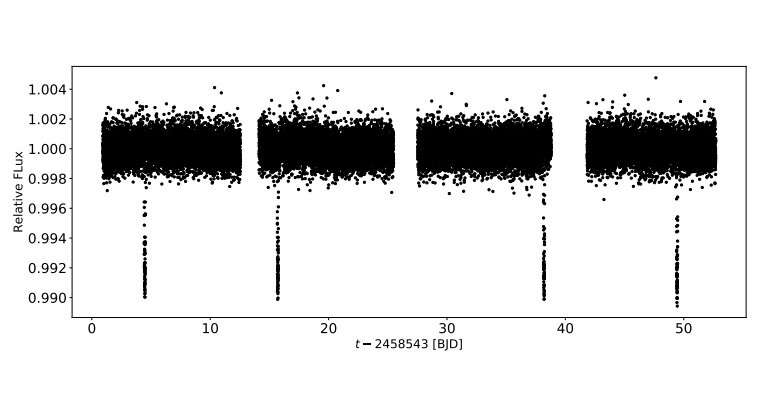November 21, 2019 report
New 'warm Jupiter' exoplanet discovered

An international team of astronomers reports the discovery of a new "warm Jupiter" alien world transiting a main sequence late F-type star on an eccentric orbit. The newfound exoplanet, designated TOI-677 b, is about 20 percent bigger and more massive than Jupiter. The finding is detailed in a paper published November 13 on arXiv.org.
The so-called "warm Jupiters" are gas giant planets with a minimal mass of 0.3 Jupiter masses and orbital periods ranging between 10 and 100 days. They mark the transition between "hot Jupiters" with an orbital period between one and 10 days and Jupiter analogues with an orbital period longer than 100 days.
TOI-677 b is the newest addition to the list of known "warm Jupiters." The object was first identified as an exoplanet candidate by NASA's Transiting Exoplanet Survey Satellite (TESS) when it observed the star TOI-677 between March 1 and April 22, 2019. Now, a group of astronomers led by Andreas Jordan of Adolfo Ibáñez University in Chile has confirmed the planetary nature of the object transiting TOI-677 by follow-up spectroscopic observations using several ground-based telescopes.
"We followed up TOI-677 with several spectrographs in order to confirm the TESS transiting planet candidate and to measure its mass," the astronomers wrote in the paper.
According to the study, TOI-677 b circles its parent star on an eccentric orbit (with an eccentricity of 0.43) every 11.23 days at a distance of about 0.1 AU from it. The planet has a radius of around 1.17 Jupiter radii and a mass of approximately 1.23 Jupiter masses. Taking into account the TOI-677 b's proximity to its host, the astronomers calculated that the planet has an equilibrium temperature at a level of approximately 1,252 Kelvin.
When it comes to TOI-677, it is a main sequence late F star with solar metallicity and effective temperature of about 6,300 Kelvin. The star has a mass of around 1.18 solar masses and its radius is about 28 percent larger than that of our sun. Observations suggest that the object is nearly 3 billion years old.
Moreover, the astronomers found evidence of a secondary long-term signal in radial velocity measurements, which could mean that the newly detected alien world is not the only object orbiting TOI-677.
"Warm jupiters can be formed via secular gravitational interactions with an outer planet followed by tidal interactions with the star in the high eccentricity stage of the secular cycle. In this context, Dong et al. (2014) predicts that in order to overcome the precession caused by general relativity, the warm jupiters produced via this mechanism should have outer planets at relatively short orbital distances that can be detected with a radial velocity monitoring," the astronomers explained.
However, they added that at the moment it is too early to draw final conclusion about the presence of an outer companion in the TOI-677 system. More studies are needed to determine the exact nature of the long term radial velocity that was reported in the paper.
More information: TOI-677 b: A Warm Jupiter (P=11.2d) on an eccentric orbit transiting a late F-type star, arXiv:1911.05574 [astro-ph.EP] arxiv.org/abs/1911.05574
© 2019 Science X Network





















